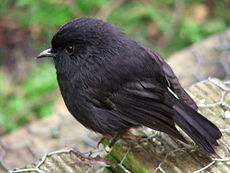- Black Robin
-
Black Robin 
Conservation status Scientific classification Kingdom: Animalia Phylum: Chordata Class: Aves Order: Passeriformes Family: Petroicidae Genus: Petroica Species: P. traversi Binomial name Petroica traversi
(Buller, 1872)The Black Robin or Chatham Island Robin (Petroica traversi) is an endangered bird from the Chatham Islands off the east coast of New Zealand. It is closely related to the New Zealand Robin (P. australis). It was first described by Walter Buller in 1872. The binomial commemorates the New Zealand botanist Henry H. Travers (1844–1928). The Black Robin is a sparrow-sized bird measuring 14–15 cm (5.5–6 in). Its plumage is almost entirely brownish-black, with a black bill and brownish-black yellow-soled feet.[1] Unlike its mainland counterparts, its flight capacity is somewhat reduced. Evolution in the absence of mammalian predators made it vulnerable to introduced species such as cats and rats, and it became extinct on the main island of the Chatham group before 1871, being restricted to Little Mangere Island thereafter.
Conservation
There are now around 250 black robins but in 1980 only five survived on Little Mangere Island. They were saved from extinction by Don Merton and his Wildlife Service team, and by "Old Blue", the last remaining fertile female. The remaining birds were moved to Mangere Island. They increased the annual output of Old Blue (and later other females) by removing the first clutch over every year and placing the eggs in the nest of the Chatham race of the Tomtit, a technique known as cross-fostering. The Tomtits raised the first brood, and the Black Robins, having lost their eggs, relaid and raised another brood.
All of the surviving black robins are descended from "Old Blue", unfortunately giving little genetic variation among the population and creating an extreme population bottleneck. Interestingly, this seems to have caused no inbreeding problems, leading to speculation that the species has passed through several such population reductions in its evolutionary past and thus losing any alleles that could cause deleterious inbreeding effects. It was generally assumed that the minimum viable population protecting from inbreeding depression was around 50 individuals, but this is now known to be an inexact average, with the actual numbers being below 10 in rapidly-reproducing small-island species such as the Black Robin, to several hundred in long-lived continental species with a wide distribution (such as elephants or tigers).
The species is still endangered, but now numbers around 250 individuals in populations on Mangere Island and South East Island. Ongoing restoration of habitat and eradication of introduced predators is being undertaken so that the population of this and other endangered Chatham endemics can be spread to several populations, decreasing the risk of extinction by natural disasters or similar stochastic events.
The female Black Robin usually lays two eggs
References
- ^ Falla, R. A., R. B. Sibson, and E. G. Turbott (1979). The new guide to the birds of New Zealand and outlying islands. Collins, Auckland.
- BirdLife International (2004). Petroica traversi. 2006. IUCN Red List of Threatened Species. IUCN 2006. www.iucnredlist.org. Retrieved on 11 May 2006. Database entry includes justification for why this species is endangered
- Butler, David; Merton, Don; (1992). The Black Robin. Oxford: Oxford University Press. ISBN 0-19-558260-8
External links
- BirdLife Species Factsheet
- "Black robin recovery plan 2001-2011" (PDF). Department of Conservation, Wellington, New Zealand. 2001. http://www.doc.govt.nz/upload/documents/science-and-technical/TSRP40.pdf. Retrieved 2007-09-19.
- Black Robin at The Internet Bird Collection.
Categories:- IUCN Red List endangered species
- Birds of the Chatham Islands
- Birds of New Zealand
- Petroica
- Animals described in 1872
- Bird conservation
Wikimedia Foundation. 2010.

